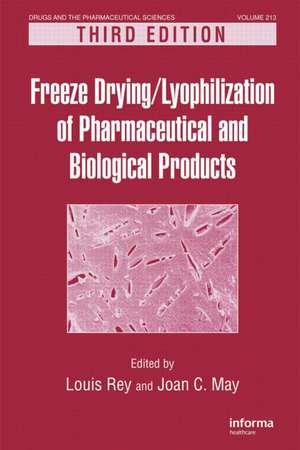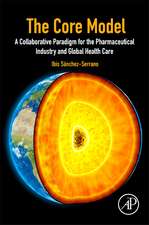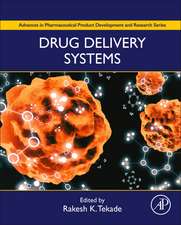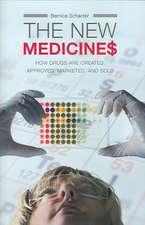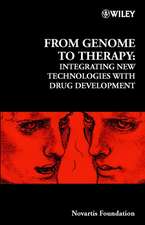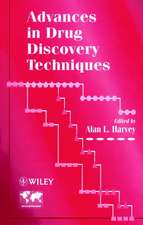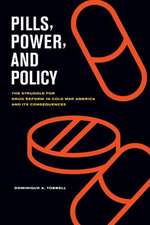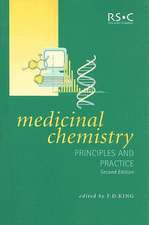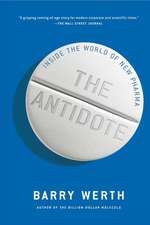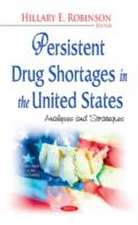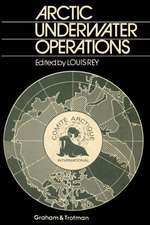Freeze-Drying/Lyophilization of Pharmaceutical and Biological Products: Drugs and the Pharmaceutical Sciences
Editat de Louis Reyen Limba Engleză Hardback – 15 iun 2010
| Toate formatele și edițiile | Preț | Express |
|---|---|---|
| Paperback (1) | 325.33 lei 6-8 săpt. | |
| CRC Press – 14 oct 2024 | 325.33 lei 6-8 săpt. | |
| Hardback (1) | 1348.33 lei 6-8 săpt. | |
| CRC Press – 15 iun 2010 | 1348.33 lei 6-8 săpt. |
Din seria Drugs and the Pharmaceutical Sciences
- 9%
 Preț: 1495.16 lei
Preț: 1495.16 lei - 9%
 Preț: 936.26 lei
Preț: 936.26 lei -
 Preț: 362.52 lei
Preț: 362.52 lei - 9%
 Preț: 574.13 lei
Preț: 574.13 lei - 5%
 Preț: 569.77 lei
Preț: 569.77 lei -
 Preț: 493.90 lei
Preț: 493.90 lei - 8%
 Preț: 547.39 lei
Preț: 547.39 lei -
 Preț: 370.76 lei
Preț: 370.76 lei - 9%
 Preț: 1315.65 lei
Preț: 1315.65 lei - 8%
 Preț: 399.14 lei
Preț: 399.14 lei - 18%
 Preț: 1544.82 lei
Preț: 1544.82 lei -
 Preț: 473.10 lei
Preț: 473.10 lei - 25%
 Preț: 1029.60 lei
Preț: 1029.60 lei - 18%
 Preț: 1544.03 lei
Preț: 1544.03 lei -
 Preț: 415.95 lei
Preț: 415.95 lei - 28%
 Preț: 988.54 lei
Preț: 988.54 lei - 12%
 Preț: 312.43 lei
Preț: 312.43 lei - 24%
 Preț: 732.04 lei
Preț: 732.04 lei - 18%
 Preț: 1287.55 lei
Preț: 1287.55 lei - 18%
 Preț: 1131.57 lei
Preț: 1131.57 lei - 15%
 Preț: 493.70 lei
Preț: 493.70 lei - 28%
 Preț: 1042.81 lei
Preț: 1042.81 lei - 29%
 Preț: 1018.82 lei
Preț: 1018.82 lei - 18%
 Preț: 783.69 lei
Preț: 783.69 lei - 22%
 Preț: 403.86 lei
Preț: 403.86 lei - 25%
 Preț: 1231.76 lei
Preț: 1231.76 lei - 27%
 Preț: 999.16 lei
Preț: 999.16 lei - 21%
 Preț: 361.46 lei
Preț: 361.46 lei - 18%
 Preț: 1285.17 lei
Preț: 1285.17 lei - 15%
 Preț: 508.28 lei
Preț: 508.28 lei - 18%
 Preț: 898.00 lei
Preț: 898.00 lei - 29%
 Preț: 1113.70 lei
Preț: 1113.70 lei - 15%
 Preț: 469.23 lei
Preț: 469.23 lei - 15%
 Preț: 585.27 lei
Preț: 585.27 lei - 31%
 Preț: 682.94 lei
Preț: 682.94 lei - 29%
 Preț: 1191.13 lei
Preț: 1191.13 lei - 15%
 Preț: 472.17 lei
Preț: 472.17 lei - 18%
 Preț: 1584.73 lei
Preț: 1584.73 lei - 18%
 Preț: 1830.13 lei
Preț: 1830.13 lei - 27%
 Preț: 1049.91 lei
Preț: 1049.91 lei - 18%
 Preț: 1342.79 lei
Preț: 1342.79 lei - 18%
 Preț: 1278.08 lei
Preț: 1278.08 lei - 18%
 Preț: 1346.72 lei
Preț: 1346.72 lei
Preț: 1348.33 lei
Preț vechi: 1644.30 lei
-18% Nou
Puncte Express: 2022
Preț estimativ în valută:
258.03€ • 280.19$ • 216.75£
258.03€ • 280.19$ • 216.75£
Carte tipărită la comandă
Livrare economică 22 aprilie-06 mai
Preluare comenzi: 021 569.72.76
Specificații
ISBN-13: 9781439825754
ISBN-10: 1439825750
Pagini: 584
Ilustrații: 37 halftones
Dimensiuni: 152 x 229 x 36 mm
Greutate: 1.07 kg
Ediția:Revizuită
Editura: CRC Press
Colecția CRC Press
Seria Drugs and the Pharmaceutical Sciences
Locul publicării:Boca Raton, United States
ISBN-10: 1439825750
Pagini: 584
Ilustrații: 37 halftones
Dimensiuni: 152 x 229 x 36 mm
Greutate: 1.07 kg
Ediția:Revizuită
Editura: CRC Press
Colecția CRC Press
Seria Drugs and the Pharmaceutical Sciences
Locul publicării:Boca Raton, United States
Public țintă
Academic and Professional Practice & DevelopmentCuprins
Foreword, Preface, Contributors, 1. Glimpses into the Realm of Freeze-Drying: Classical Issues and New Ventures, 2. Structural and Dynamic Properties of Bulk and Confined Water, 3. Freezing and Annealing Phenomena in Lyophilization, 4. Phase Separation of Freeze-Dried Amorphous Solids: The Occurrence and Detection of Multiple Amorphous Phases in Pharmaceutical Systems, 5. The Use of Microscopy, Thermal Analysis, and Impedance Measurements to Establish Critical Formulation Parameters for Freeze-Drying Cycle Development, 6. The Relevance of Thermal Properties for Improving Formulation and Cycle Development: Application to Freeze-Drying of Proteins, 7. Freezing- and Drying-Induced Perturbations of Protein Structure and Mechanisms of Protein Protection by Stabilizing Additives, 8. Mechanisms of Protein Stabilization During Freeze-Drying Storage: The Relative Importance of Thermodynamic Stabilization and Glassy State Relaxation Dynamics, 9. Formulation Characterization, 10. Practical Aspects of Freeze-Drying of Pharmaceutical and Biological Products Using Nonaqueous Cosolvent Systems, 11. Regulatory Control of Freeze-Dried Products: Importance and Evaluation of Residual Moisture, 12. Freeze-Drying of Biological Standards, 13. Molecular Mobility of Freeze-Dried Formulations as Determined by NMR Relaxation Times, and Its Effect on Storage Stability, 14. Scanning Electron Microscopy: A Powerful Tool for Imaging Freeze-Dried Material, 15. Pharmaceutical Packaging for Lyophilization Applications, 16. Closure and Container Considerations in Lyophilization, 17. Extractables and Leachables as Container Closure Considerations in Lyophilization, 18. Optimizing the Throughput of Freeze-Dryers Within a Constrained Design Space, 19. Monitoring and Control of Industrial Freeze-Drying Operations: The Challenge of Implementing Quality-by-Design (QbD), 20. Process Analytical Technology in Industrial Freeze-Drying, 21. Practical Considerations for Freeze-Drying in Dual Chamber Package Systems, 22. Lyophilization and Irradiation as an Integrated Process, Appendix: Table, Saturation Vapor Pressure Of Ice, Index
Descriere
Freeze-drying, or lyophilization, is a well established technology used in the preservation of numerous pharmaceutical and biological products. This highly effective dehydration method involves the removal of water from frozen materials via the direct sublimation of ice. In recent years, this process has met with many changes, as have the regulations that impact lyophilization practices. This volume addresses these changes with revised chapters on emerging developments in lyophilization technology, research, and industry procedures. Providing both a scientific and industrial perspective, this comprehensive text is a valuable resource for all those who use freeze-drying technology.
